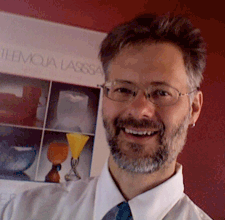Pilgrim Reindeer in Pisa, 1348
a free multimedia novel by
Thomas A. DuBois, University of Wisconsin-Madison
 |
Pilgrim Reindeer in Pisa, 1348 a free multimedia novel by Thomas A. DuBois, University of Wisconsin-Madison |
|
|
|
1. Part I Setting Out 14. Vadstena [August 30, 1347]
This chapter was exciting to me, because I got to depict two women whom I have studied for a long time. Catharina and her mother Birgitta are some of the most famous women in Nordic history. Birgitta was an imposing figure: a powerful advisor to the royal couple and a prolific visionary. In some of her visions, the Virgin Mary upbraids her for inattentiveness to Catharina's needs, and I sought to illustrate that tendency here. It cannot have been easy to have a saint for a mother, particularly if that mother spent most of her quality time talking to her spirtual spouse Jesus.
The Catharina figure also reflects my readings of her life and career. Catharina became crucial to her mother's work in Italy and eventually became the first abbess of her mother's new order, but she resolutely and characteristically avoided taking the spotlight herself. Sadly, scholars have tended to accept Catharina's wall-flower image without question, missing a real appreciation of one of the most prominent and empowered women in Nordic medieval history.
I also wanted to make Bávlos have his very first extended conversation in Swedish with Catharina. He ends up calling her Fina, which becomes an important detail much later in the novel. Den fina frun, the phrase that Bávlos misinterprets as her name, actually means "the fine lady," and illustrates an interesting grammatical feature of Swedish: the use of a suffixed -n or -t as a definite article. In conjunction with the definite article, the adjective fin becomes fina.